According to Nonfungible.com, NFTtrading volume has reached $17.6 billion untill 2021, a 21,000% increase from that of 82 million in 2020. More than 2.5 million crypto wallets in 2021 belong to those who hold or trade NFTs, while there was only around 89,000 a year ago. The number of buyers rose from 2.3 million to 7.5 million. Although the NFT market is progressing rapidly in 2021, at present, the total trading volume of the NFT market is only 20 billion US dollars. The 24-hour trading volume of decentralized exchanges has reached more than 3.7 billion US dollars, while the 24-hour trading volume of centralized exchanges has reached tens of billions of dollars. It can be derived that the actual size of the NFT market is very small and in an early development stage, whose growth potential is large in the future.
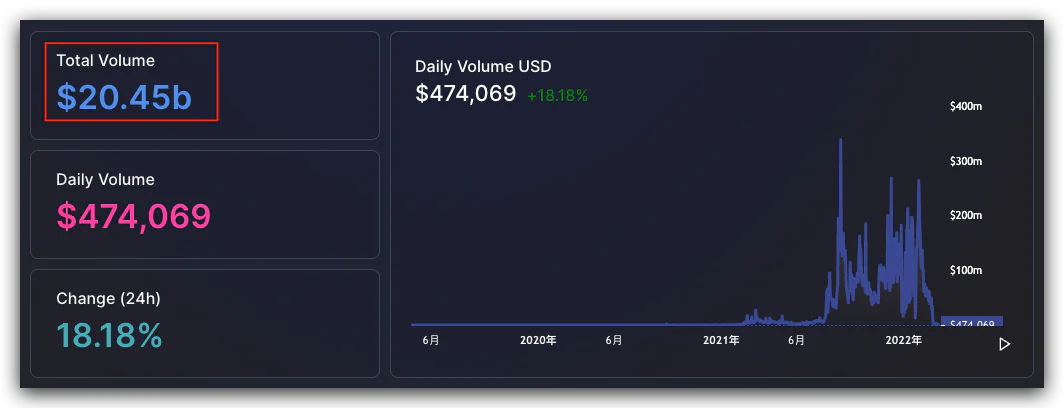
source: DefiLlama
Opensea is under threat?
In recent news, you may often see such news, "XX platform trading volume exceeds Opensea...", "Opensea's status is under threat...".
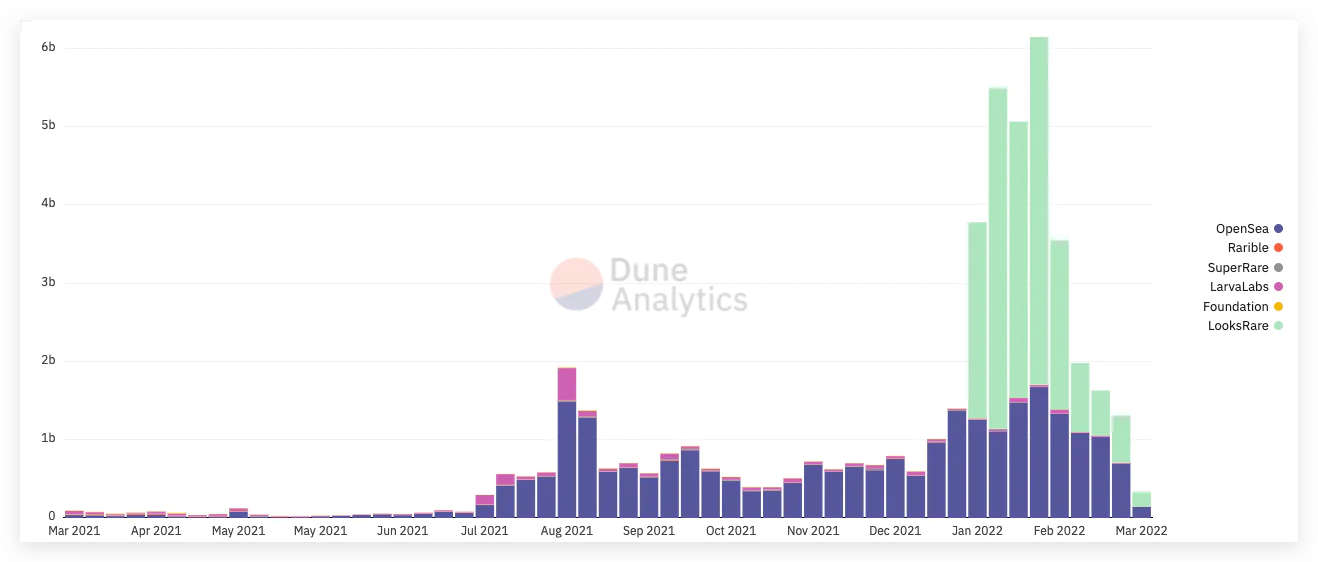
source: Dune Analytics @thomas_m
As mentioned below, Opensea has always been threatened or challenged by many competitors.
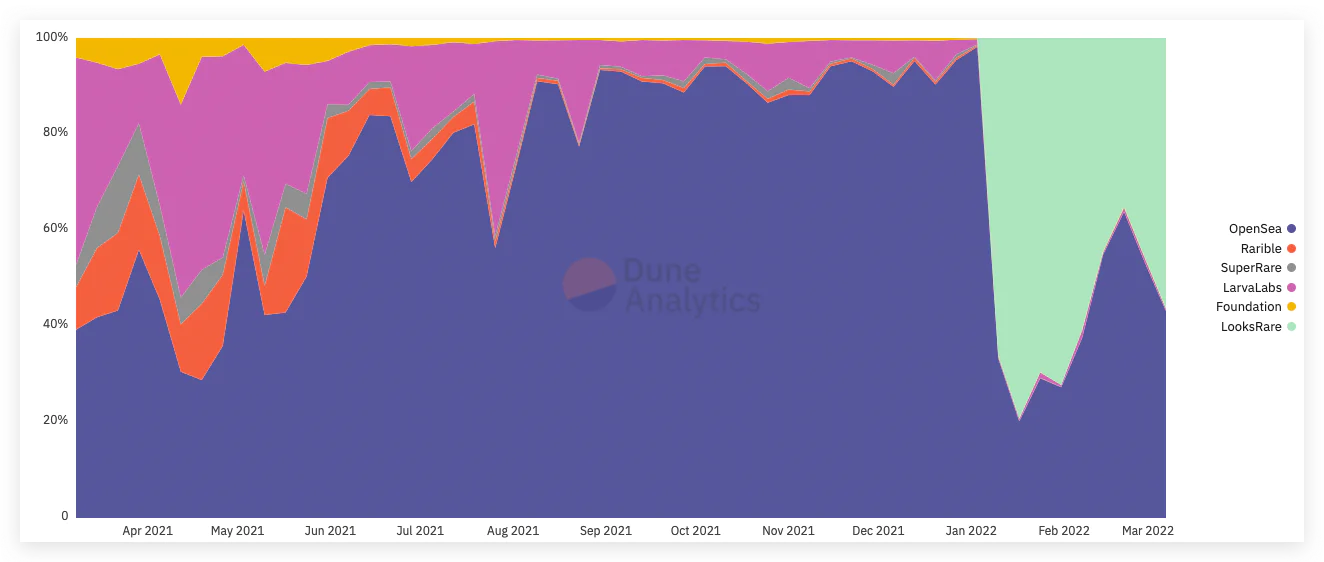
source: Dune Analytics @thomas_m
The news might not be the truth...
LooksRare's recent high trading volume is due to the fact that the platform is engaged in trading mining. However, after digging into some data, we find that the actual situation might not be so ideal. As shown in the following two figures, in terms of user volume, LooksRare and Opensea have almost a 10-fold gap.
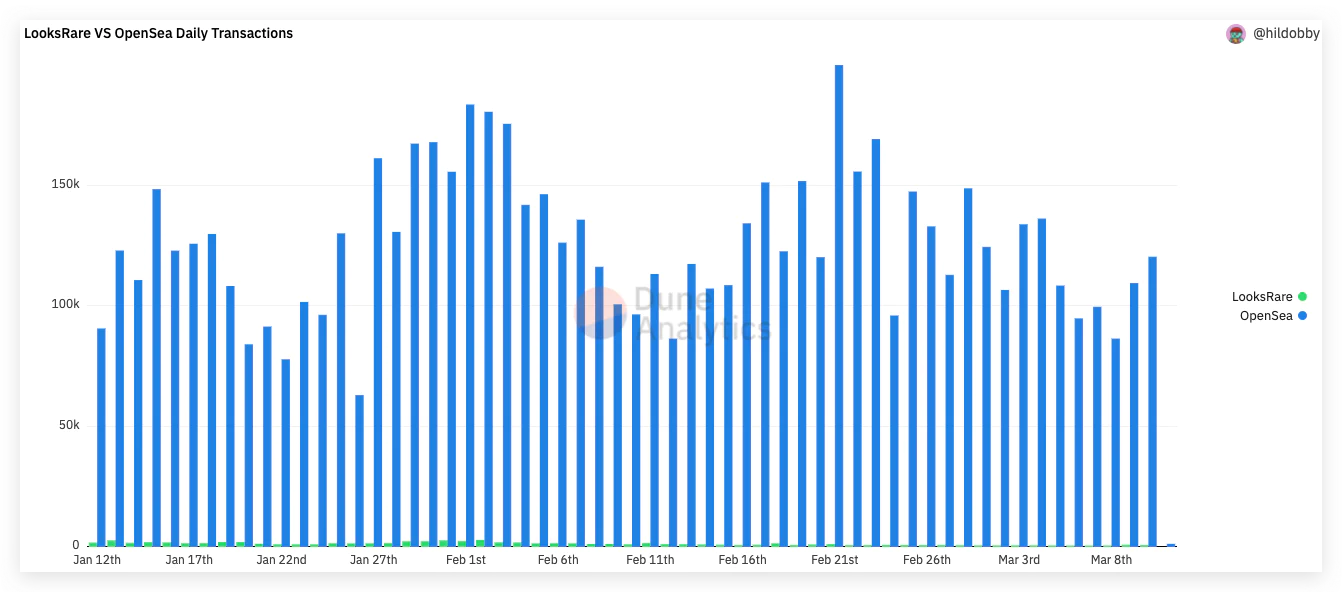
source: Dune Analytics @hildobby
In terms of trading volume, most of the users who use LooksRare trade by high-value NFTs. Therefore, in terms of trading volume , there is also a difference of more than 10 times.
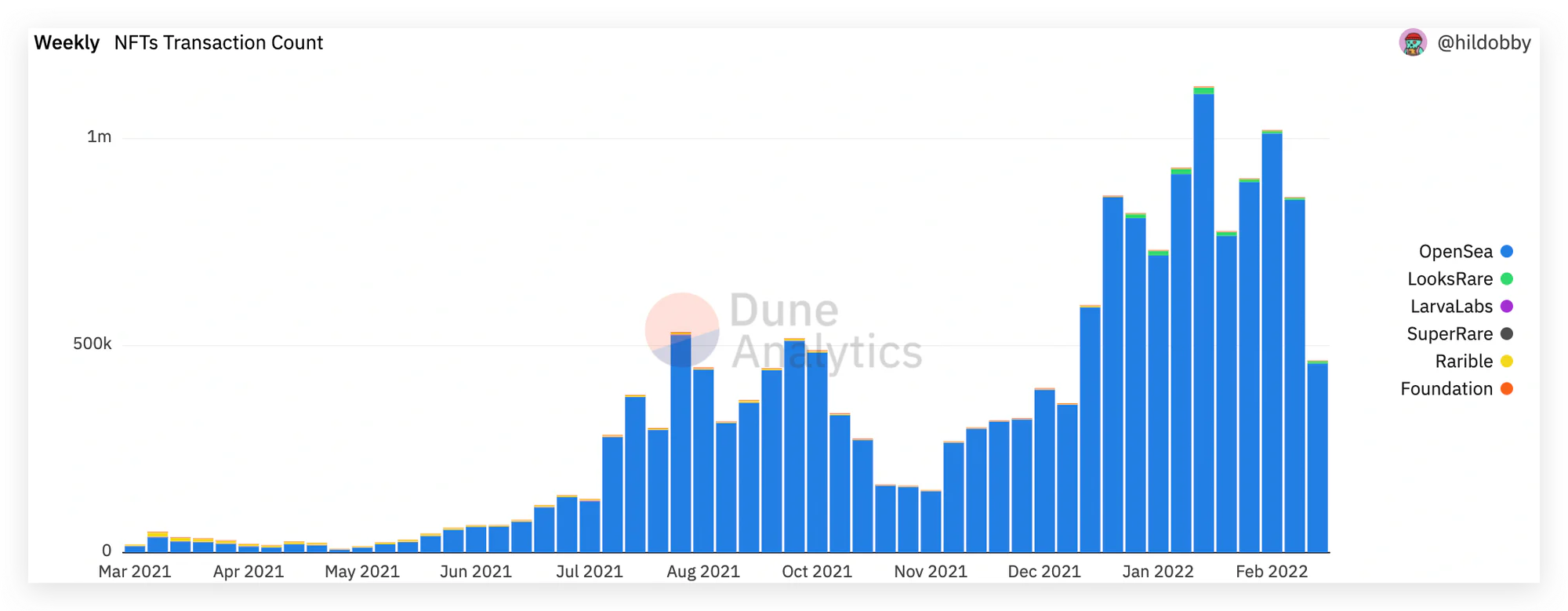
source: Dune Analytics @hildobby
Recent frequent transaction mining is the main reason for LooksRare’s exploding trading volume. In order to minimize mining costs, all participants of trading mining choose NFT projects with zero copyright royalty. Removing the trading volume of those parts, the remain is shown in the figure below. Other platforms are still far from trading volume of Opensea.
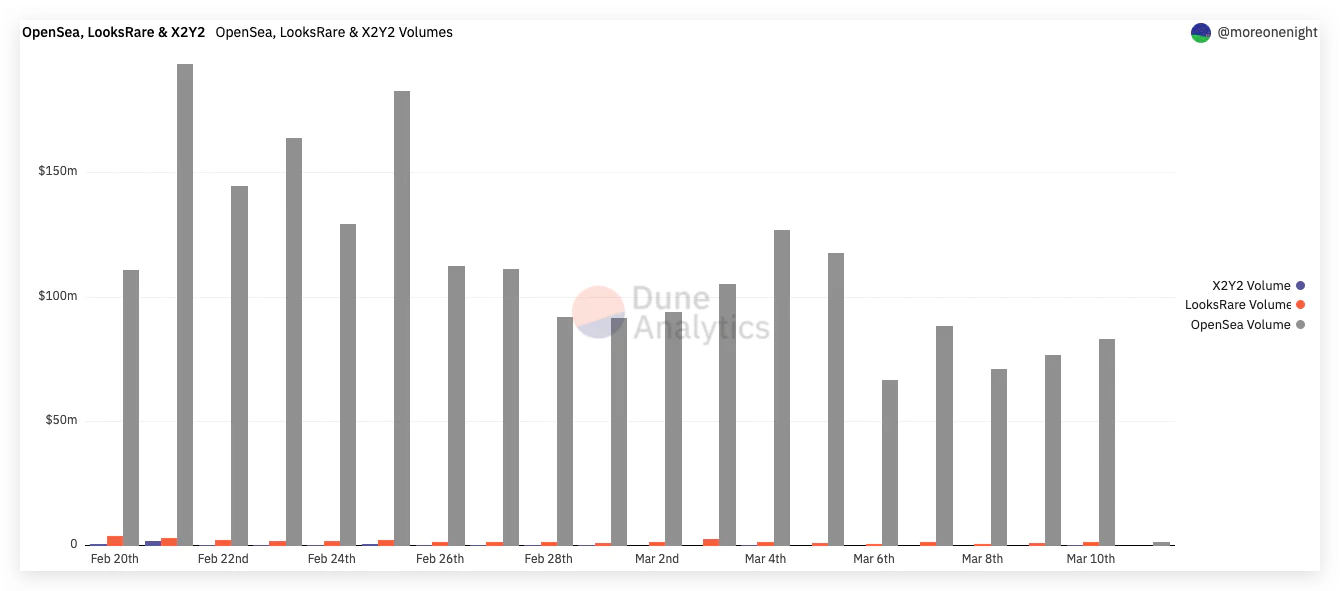
source: Dune Analytics @moreonenight
Through the above analysis, it is not difficult to conclude that Opensea is in a dominant position of NFT trading platforms. As shown below, Opensea occupies more than 90% of the NFT trading market. Since the current NFT market is still in an early stage and the following chart data may be incomplete, the statistical results are still very useful for reference.

source: DefiLlama
In fact, not only monopolizing in the trading market, in the multichain chain Opensea is still the boss. As shown below, the market value of NFTs on Ethereum accounts for more than 90% that of the overall.

source: DefiLlama
Although Opensea owns an absolute monopoly in the NFT market, it is certain that the market is too large to be dominated forever. Its competitors are still worthy of attention. Maybe when the next opportunity comes, Opensea's challenger will born. The current NFT trading platforms with high attention are shown as below.
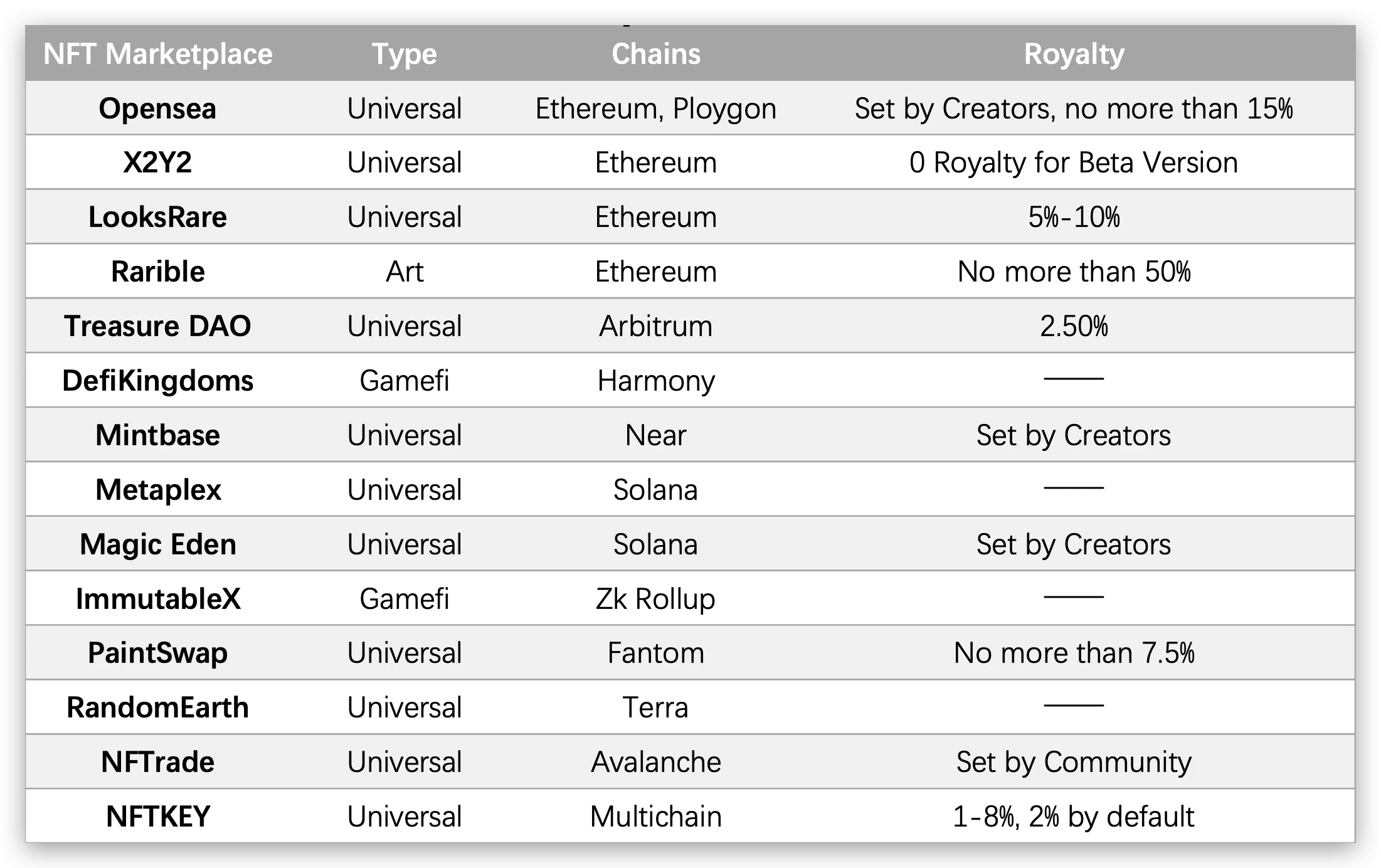
Current NFT trading platforms
Where are Opensea's challengers or collaborators? When do they appear?
Looking back at the history of Cryptocurrency exchanges, we will find some clues. In the figure below, the lower, middle, and upper layers respectively state the establishment, closure or bankruptcy of representative exchanges in different periods, as well as Chinese policies affecting the industry.

The history of Cryptocurrency Exchanges
From the timeline, the development history of traditional cryptocurrency exchanges can be divided into three periods.
The first period - the age of Bitcoin. After launched in 2009, Bitcoin gradually attracted the attention of the geek, and the transaction demand gradually increased. In 2010 and 2011, exchanges such as Mt.Gox and BTCC (Bitcoin China) were established successively to meet the growing demand for trading. However, altcoins such as Litecoin, Dogecoin, and colored coins also appeared in that period, most of which were Fork of Bitcoin. In the mid-to-late 2013, the market gradually reached a climax. China became the market with the largest Bitcoin trading volume, and BTCC surpassed exchanges such as Mt.Gox to become the largest exchange in the world. That caught the attention of the Central Bank of China, which issued the "Notice on Preventing Bitcoin Risks" on December 3, 2013, opening the first bear market in the Bitcoin market. It is worth noting that cryptocurrency exchanges such as Bitfinex, Huobi, OK, and Pixiu Exchange (later renamed Yunbi) were established during that period. In 2014, Mt.Gox declared bankruptcy after losing ten thousands of bitcoins due to security issues. BTCC has ranked first in the world in terms of bitcoin trading volume for the next three years.
The second period - the ICO era. After two years of bear market, Ethereum went online in 2015. Smart contracts had realized for the first time and issuing ERC20 Tokens become very simple, The era of ICO ushers. A large number of altcoins appeared at that time, and Yunbi was the first to list ETH and other altcoins among many exchanges. By seizing the opportunity of the altcoin outbreak, Yunbi became the largest exchange in the world at that time. In this process, it is worth mentioning that BTCC, due to its focus on Bitcoin trading, missed the golden time period for the outbreak of altcoins, and then lost the "throne" of the world's largest exchange. At that time, although exchanges such as Huobi and OK were not as radical as Yunbi, they changed thoughts in time and maintained their status as the top exchanges. The market culminated in 2017, when China remained the largest market for cryptocurrency trading, and Binance went live on July 14 of that year. On September 4, 2017, seven ministries including the Central Bank of China banned ICOs and characterized them as illegal fundraising. In the following month, Yunbi and BTCC announced their closures. The cryptocurrency market rallied sharply in the three months that followed, reaching an all-time high in December before kicking off a two-year bear market. Fcoin is a small episode in that period. It was announced on May 21, 2018. Through transaction mining, it took only half a month to reach a market value of 60 billion, becoming the world's largest exchange in terms of trading volume. However, it only took 100 days for transaction mining until Fcoin announced its closure on February 18, 2020.
The third period - the DeFi era. In 2020, the market began to recover after a two-year hiatus and a “March 12th” crash. Binance, Huobi, OK and other exchanges moved their headquarters overseas to continue their trading business after the central bank stopped ICOs in 2017. Among them, Binance was the most aggressive, it only took two years to become the world's largest centralized exchange (CEX). And it has maintained its monopoly until now.

source: CoinGecko
Since 2021 the market gradually gets hot, and DeFi has become the fuse of this bull market. Among them, Compound started the DeFi Summer through liquidity mining. Uniswap has also become the world's largest decentralized exchange (DEX), but looking back on the history of Uniswap, its rise is not directly due to "decentralization". After 2018, most of the centralized exchanges have high listing fees. Many small and medium-sized projects cannot afford this part of the cost, but their trading needs still exist. Uniswap has greatly lowered the threshold for token listing and trading through the AMM algorithm with no listing fees, thus capturing the trading demand of a large number of long-tail assets and gradually growing into the world's largest decentralized exchange. Since then, various types of DEXs such as Curve, 1inch, and dYdX have risen. The daily trading volume of DEX, as shown in the chart above, has reached $3.7 billion. Since the marginal cost of DEX's growth is almost zero when the performance of the public chain allows it, it is foreseeable that with the resolution of the performance of the public chain, DEX and even the entire DeFi will gradually replace CeFi.
The following table briefly summarizes the key conditions or reasons why each representative exchange can become a head.

After reviewing the history of traditional cryptocurrency exchanges, it is easy to see that the real giants are usually born in the midst of change, and the specific reasons for this can be divided into two main categories.
I. The fall of the previous generation of giants
There are both internal and external reasons for the fall of giants, such as Mt.Gox, which went bankrupt due to its own security issues. Although BTCC did not become a global exchange because of Mt.Gox's bankruptcy, its bankruptcy also left BTCC with a very strong rival. And like Yunbi and BTCC belong to external reasons to close, and their closure gives the opportunity and space for exchanges like Binance and Huobi to rise.
II. The emergence of new opportunities or tracks
Throughout the history of traditional cryptocurrency exchanges, the rise of each group of exchanges has been due to the emergence of new trading needs or tracks. To summarize, Mt.Gox and BTCC seized the demand for Bitcoin trading, Cloudcoin seized the opportunity of the explosion of ethereum and cryptocurrency, and Binance and Huobi seized the growing demand for trading after the closure of Cloudcoin and BTCC. The rise of Uniswap is due to the advancement of smart contracts and other technologies and the improvement of AMM algorithm, which has captured the demand for coin and transaction of long-tail assets.
Returning to NFT, we have to ask if Opensea can stay on top of the NFT market forever? And where are its challengers, or partners?
We can try to solve several of the above problems from the Cryptocurrency exchange development experience. I think we first need to understand which points seem important, but actually not the points worthy of attention in the process of finding new giants.
First, decentralization. The word decentralization is one of the most frequently featured words in the Crypto industry, and players are using decentralization as a key indicator of their projects. But it is also the reason why decentralization became the standard for various projects, especially after the rise of DeFi, where the feasibility of smart contract development was fully validated. As a result of this, the vast majority of NFT exchanges born after this period are decentralized. On the other hand, decentralization is an influence that is deep, and decentralization is often not directly responsible for whether a project can truly explode. For example, before the outbreak of Uniswap, there have been several DEX attempts, most of which ended in failure, because in terms of user experience, DEX and CEX at that time did not have a fighting chance, and even now, there is still a big gap between the user experience of DEX and CEX. Therefore decentralization should not be a point to focus on in the process of finding a new giant.
Second, micro-innovation. There are some NFT exchanges claiming to have better rates and more user-friendly features than Opensea, hoping to attract more users this way. But the results have been very obvious, there is no NFT exchange through micro-innovation to shake Opensea's position. Looking back at the history of FT exchanges, it is easy to see that during the "peaceful" period, the position of the giants was very difficult to shake. The essence of the reason is that micro-innovations are usually small improvements in user experience or low-barrier improvements, but the user habits themselves are very difficult to change, and it is difficult for most users to switch to other platforms because of small changes.
Third, short-term high incentive. In the chart at the beginning of this article, it is easy to find that while LooksRare has achieved a bright performance in terms of trading volume through liquidity mining, it is easy to see from other data that there is a huge gap between its real user base and Opensea. Looking back at Fcoin's history, trading mining has only allowed its trading volume to surge in the short term. The reason why short-term high incentives do not create giants is that high incentives attract mostly woolly parties, not the real target users of the platform. So the platform still needs to consider the retention of users, how many real users remain after the incentive is the most important thing to consider. And in the early stages of the platform, short-term high incentives will instead pull up user expectations in advance, making the platform into a kind of Ponzi bubble, when this bubble burst, but will cause permanent damage to the platform.
Of course, it should be emphasized that high short-term incentives are not a negation of liquidity mining or transaction mining. On the contrary, appropriate "mining" incentives at different stages can be beneficial to a project's development, such as Compound's liquidity mining, which has led it to take the top spot in the DeFi lending protocol.

source: looksrare.org
So what do we need to look for when looking for a challenger for Opensea?
It is easy to find out from the above analysis that unless there is a major opportunity or change, it is extremely difficult to challenge the status of the giants, and the pattern of the NFT market will probably follow the same rule, if the NFT market is stable and Opensea does not close down or fall due to internal and external factors, it will be very difficult for new giants to challenge Opensea's status. However, as mentioned at the beginning, the NFT market is still very small, and NFT has great potential as an important crypto medium, so there are still a lot of opportunities and changes in the direction of NFT in the future, and Opensea will probably not be the only one forever, after all, there is a common problem that it is hard to turn around when the boat is too big for the giants.
Therefore, if we are looking for a challenger to Opensea, we should look for new opportunities and changes. There are currently the following opportunities:
GameFi : Although the market experienced a wave of "GameFi" bubble at the end of 2021, in fact, most of the GameFi in 2021 are DeFi projects or funding plates in the guise of games, and cannot be called GameFi in the real sense. I personally believe that the core of GameFi is still Game, and gameplay is still the goal of GameFi, while Finance is more of a transformation of Game's original game mechanics and financial system. It will take time for projects with strong gameplay and Crypto attributes to emerge, so I believe there will be more and more GameFi projects in the real sense in the future.
It is worth noting that most GameFi projects come with their own trading market, and such trading market is usually customized according to the game itself, so it is difficult for third-party projects to get a piece of the cake. However, as the number of such projects increases, and based on the combinable nature of the blockchain, asset trading exchange between games will likely become a new demand, future projects for this track are worthy of attention.
Multi-chain ecology : Eth 2.0 has been slow to land resulting in Eth not meeting the growing demand, giving other public chains room for significant growth in 2021. With the popularity of blockchain, the future will definitely be a state of multiple chains co-existing. Although the majority of valuable NFTs are currently concentrated on Eth, the volume of NFTs on other public chains will inevitably grow as their ecology grows. Along with the prosperity of multi-chain ecosystem, the cross-chain demand for NFT will also grow accordingly. Therefore, the NTF market of other public chains and the demand for cross-chain transactions are worth paying attention to in the future. For example, Mintbase on Near, Metaplex on Solana, etc. With the prosperity of multi-chain ecosystem, these platforms will have the opportunity to challenge Opensea.
In addition to the above two areas of concern, as Web3 continues to evolve, new opportunities or changes are sure to emerge in the future, so we need to continue to follow up and discover Opensea's challengers.
Opensea's collaborators or followers are still worth watching
All of the above has been about what it takes to challenge Opensea to become the next generation of giants, and what opportunities to watch for. But as mentioned at the beginning of this article, the NFT market is still very much in its early stages, and while there are huge gains to be made by challenging Opensea to become a new giant, it will also be much more difficult. In the history of traditional cryptocurrency exchanges, Coinbase, Huobi, OK, Bitfinex, and others have not become the top one, but they have also made significant profits as the industry continues to grow.
Opensea is an universal NFT exchange that does a great job in the breadth of project types, supporting Art, PFP, Music and other types of NFT, but it may not be able to take care of some of the deeper features, such as Genie, a project that enables bulk buying and selling of NFT as well as pending orders. Similarly, the current NFT rarity property is still underutilized, for NFT rarity pricing and trading may also be a good opportunity.
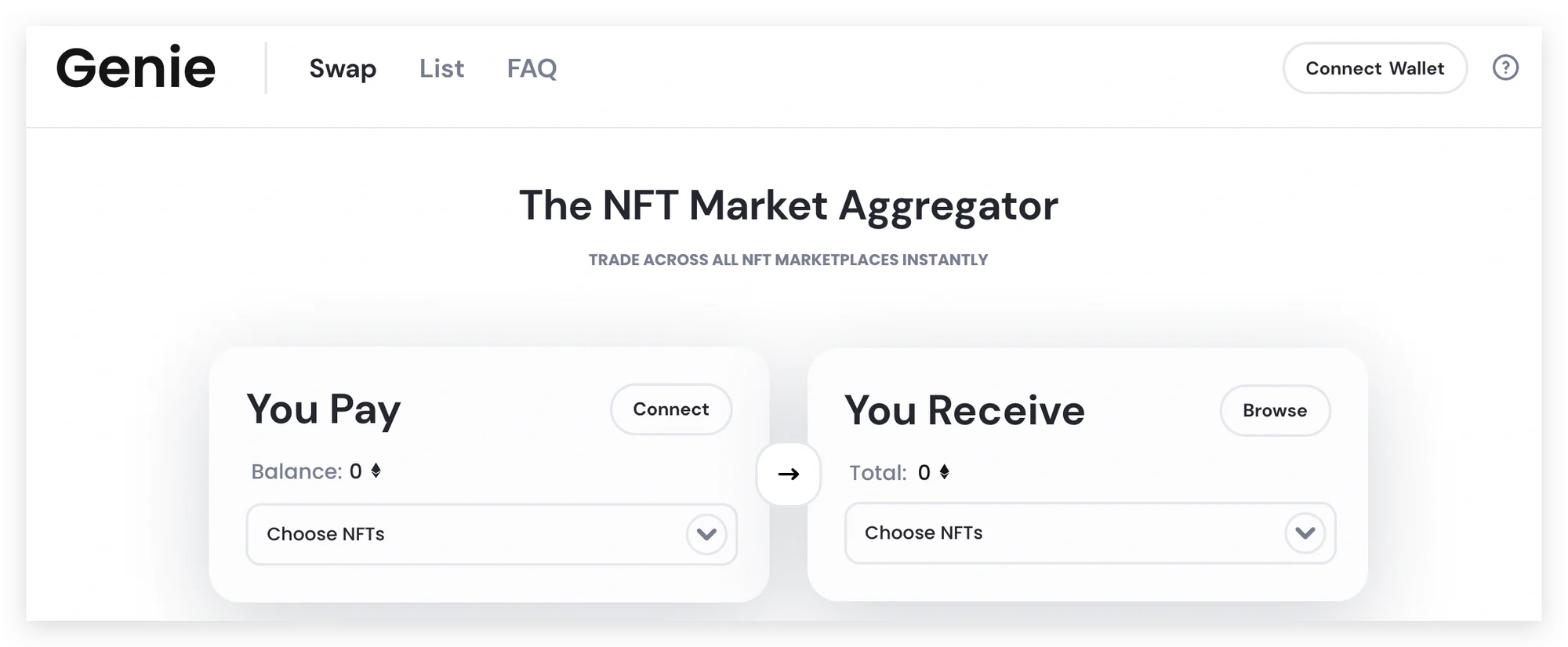
source: Genie
In addition to complementing Opensea's functionality, there are still large gaps in the NFT derivatives, lending and other markets, and there are still huge opportunities in this part of the market, for which Opensea can act as a source of information, providing them with information on floor prices, pending orders, etc.
In conclusion, with the development of the NFT circuit, there are still many opportunities waiting to be explored in the future, and both Opensea's challengers and collaborators will have significant earnings in the future, as long as they can grow with the industry.